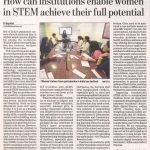 40% of India’s population consists of youth and every year 12 million people become eligible for joining the workforce. Women’s labour force participation has, however, declined. Women also earn less.
40% of India’s population consists of youth and every year 12 million people become eligible for joining the workforce. Women’s labour force participation has, however, declined. Women also earn less.
This is partly because of gender stereotypes and low expectations that keep girls away from the higher paying science and technology sectors. According to UNESCO, only 30% of all girl students in India selected Science, Technology, Engineering and Mathematics (STEM) related fields in higher education. This situation needs to change.
Seven important skills have been identified globally that need to be emphasised in the foundation years around STEM-based skill development. They are problem-solving, creativity, argumentation, intellectual curiosity, statistics, data-driven decision-making and flexibility. Work on these dimensions must start early; Grades 6 to 8 act as a foundational period for nurturing leadership skills, scientific enquiry and innovative thinking, which become the building blocks enabling the next generation to contribute in the future. However, infrastructure for children to take the first steps to experience science is missing. Country-wide data from the Unified District Information System for Education (DISE) reveal that barely 20-22% secondary schools have laboratory facilities for Physics, Chemistry and Biology. Despite India being at the forefront of the ICT revolution, only, 26.86% schools have computer labs; the numbers are even lower at the upper primary levels.
When facilities exist, the ability of teachers to impart and encourage STEM education, especially amongst girls, is another important consideration. Gender norms must be broken, and teachers must have the faith that girls can do science, become engineers, scientists and perhaps one day contribute to India’s space programme. Teachers need to be in turn supported with access resources, tools and methods to address the diverse teaching-learning needs of children, especially girls. They need to break their own notions of what girls can and cannot do that they learned in childhood.
The solution also lies in addressing the barriers that keep marginalised children, especially girls, in rural and remote geographies from pursuing STEM-based opportunities by providing them access to facilities that they need to feel, touch and experience science. One solution is establishing decentralised micro labs, which provide access to laboratories, Information and Communication Technology (ICT) and teaching-learning resources around STEM for both teachers and children at the school and cluster levels. The Uttar Pradesh government is currently upscaling one such model—the Teachers’ Resource Labs.
Positive role models for girls in their immediate context need to be created and community’s perception that girls cannot learn Science and Mathematics broken. Girls need to be mentored to use methods based on scientific enquiry not only for career options, but also to evolve innovative solutions for their everyday problems around health, nutrition, sanitation and ways of living. Encouraging girls to develop Science-applicative projects and technology-based solutions to address problems in their community enhances their scientific aptitude and self-esteem. A broader STEM network of mentors supporting children from marginalised context, like teachers, scientists, academics and STEM professionals expose these children, especially girls to positive role models. Such an ecosystem will also help the new generation to pursue career options of their choice, enabling them to make a difference for themselves and society at large.
Imparting foundational STEM skills to marginalised children forms an important component of ensuring girls take informed vocational choices. Basic digital literacy, coding ability, creating apps and designing business models are simple skills that all children, especially girls from marginalised families, need to be exposed to make them a part of the digital revolution. By not equipping them with these skills, India will lose out on the participation of millions of young people who could have contributed to the inclusive digital revolution in the country. India cannot afford this loss.
This article written by Gayathri S, Senior Technical Specialist, CARE India, appeared in Hindustan Times on October 24, 2018




